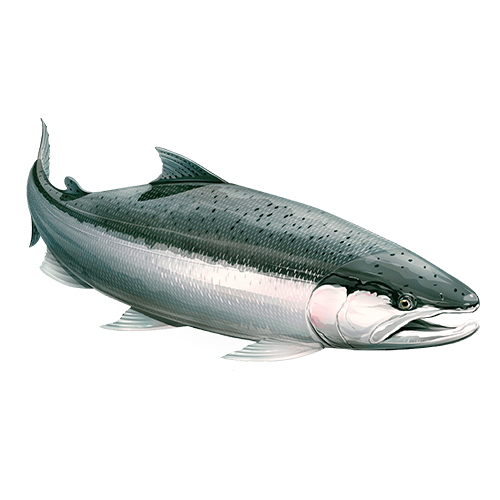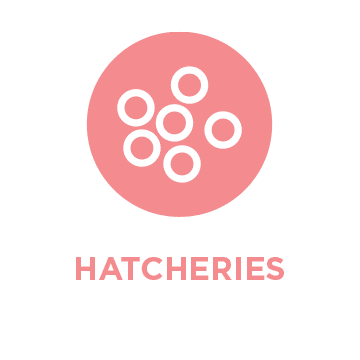How we're working to save them:
- Remove the four lowermost Klamath dams to allow fall-run Chinook salmon to access historical spawning habitat upstream.
- Adaptively manage streamflows and habitat restoration as part of the Trinity River Restoration Program to increase abundance of UKTR fall-run Chinook salmon and their habitat.
- Update hatchery practices at Trinity River Hatchery to reduce competition, predation, loss of genetic diversity, and life history diversity in wild salmonids.
- Limit harvest to only adipose fin clipped hatchery Chinook to determine hatchery impacts on wild fish and inform Chinook re-colonization efforts in the upper Klamath River Basin after dams are removed.
- Improve habitat and flow conditions in the Shasta and Scott rivers, which provide reliable cold water habitat.
Click here to learn about CalTrout’s overall “Return to Resilience” plan to save California’s salmonids from extinction.
Where to find Upper Klamath-Trinity Rivers Fall-Run Chinook Salmon:
Upper Klamath-Trinity Rivers Fall-Run Chinook Salmon Distribution
UKTR Chinook salmon are found in all major tributaries of the Klamath River upstream of the Klamath-Trinity rivers confluence.
How they Upper Klamath-Trinity Rivers Fall-Run Chinook Salmon Scored:


Characteristics
UKTR fall-run Chinook are sexually mature fish that enter the Klamath Estuary during late summer to early fall and spawn shortly after reaching their natal spawning grounds. In general, UKTR Chinook spawning adults are smaller, more rounded, and heavier in proportion to their length compared to Central Valley Chinook due to their shorter migrations. Today, UKTR fall-run Chinook salmon are part a component of commercial, recreational, and tribal subsistence fisheries.
Abundance
The Upper Klamath-Trinity rivers historically produced several hundred thousand fall-run Chinook annually before gold mining severely impacted the watersheds toward the end of the nineteenth century. Hatchery operations have supplemented UKTR fall-run Chinook returns since the completion of Iron Gate Hatchery on the Klamath River and Trinity Hatchery on the Trinity River in the 1960s. Since 2010, returns of fall-run Chinook in the UKTR basin varied averaged approximately 150,000 fish; however, in 2012, over 300,000 fish were recorded, the most on record since accurate record keeping began in 1978.
Habitat & Behavior
Adult UKTR fall-run Chinook salmon enter the Klamath Estuary from early July through September, and slowly migrate upstream from mid-July to October as temperatures decrease. In the Trinity River, fall-run Chinook salmon migration occurs between September and December. Spawning can occur over several months depending on the tributary, but generally peak between November and December, which is one to four weeks later than occurred historically. UKTR Chinook salmon have larger and fewer eggs than those from the Central Valley. While most UKTR fall-run Chinook are three years old when they spawn, in some years, two year-old small male salmon, called grilse, can make up a large proportion of the run. Juvenile UKTR Chinook salmon exhibit one of three life strategies: (1) rapidly migrating to the ocean; (2) spending summer months in cool tributaries until migrating out to sea in the fall; and (3) spending over a year in fresh water feeding before migrating to sea. A very rare fourth strategy has been documented in the spring-fed Shasta River, where male parr salmon mature entirely in fresh water and may spawn multiple times throughout their lives. Life history strategies depend on food availability, streamflows, water temperature, and other factors.
Genetics
UKTR fall-run Chinook are more similar to UKTR spring-run Chinook than they are to other fall- run Chinook in lower Klamath River tributaries.
- All
- _proof
- 50th
- Action Alert
- Bay Area
- Bay Area
- Blue Ribbon Waters
- California Water
- CalTrout People
- CalTrout Promo
- Campaigns
- Central Valley
- Central Valley
- Dams
- Diversity Equity Inclusion
- Eel River
- Event
- Events
- Featured
- Featured Watersheds
- Field Notes
- Fly Fishing
- From CalTrout
- Fun
- Hat Creek Restoration Project
- Imperiled Native Trout
- Initiatives
- Integrate Wild Fish & Working Landscapes
- Integrate Wild Fish & Working Landscapes
- Integrate Wild Fish and Working Landscapes
- Invasive Species
- Job Postings
- Key Initiative
- Klamath River Restoration
- Legal & Policy
- Legislation
- Migration Matters
- Mount Shasta / Klamath
- Mt. Lassen
- Mt. Lassen
- Mt. Shasta/Klamath
- News
- North Coast
- North Coast
- Podcast
- Podcast
- Press Releases
- Protect The Best
- Protect the Best
- Protect The Best
- Protect The Best
- Reconnect Habitat
- Reconnect Habitat
- Reconnect Habitat
- Regions
- Restore Estuaries
- Restore Estuaries
- Restore Estuaries
- Science
- Science Into Action
- SCRSC
- Sierra Headwaters
- Sierra Headwaters
- SOS Report
- South Coast
- South Coast
- Steelhead & Salmon
- Steward Source Water Areas
- Steward Source Water Areas
- Streamkeeper's Blog
- Trout
- Uncategorized
- video
- Voices of the Watershed
- Water Talks
- Women of CalTrout
- Youth


























 Dams block access to historical spawning and rearing habitats. Downstream, dams alter the timing, frequency, duration, magnitude, and rate of change of flows decreasing habitat quality and survival.
Dams block access to historical spawning and rearing habitats. Downstream, dams alter the timing, frequency, duration, magnitude, and rate of change of flows decreasing habitat quality and survival.